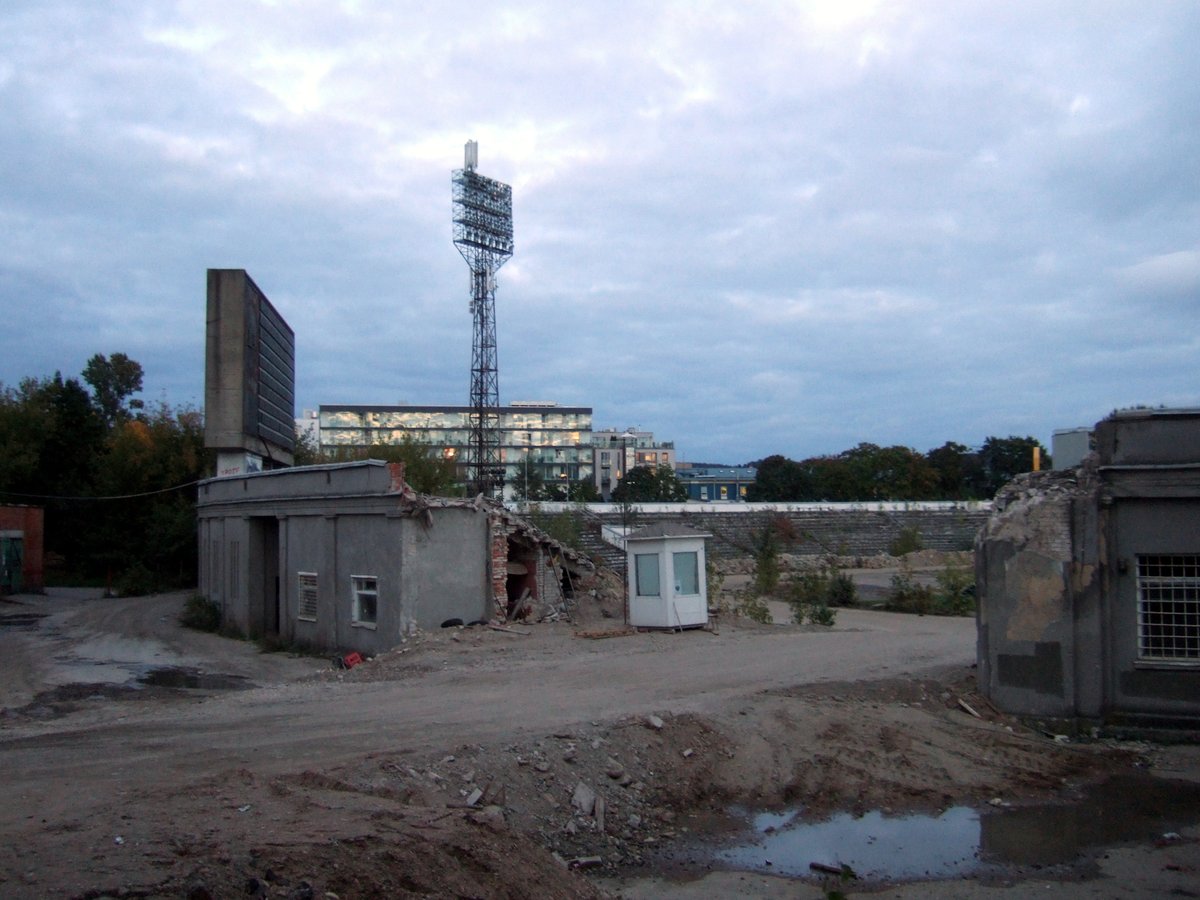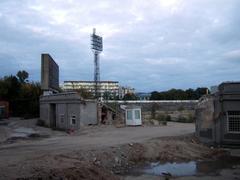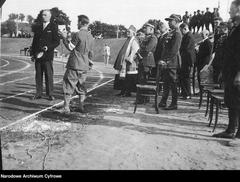
Complete Guide to Visiting Žalgiris Stadium, Vilnius, Lithuania: Tickets, Hours, and Nearby Attractions
Date: 15/06/2025
Introduction
Žalgiris Stadium in Vilnius, Lithuania, was a landmark that embodied the city’s rich tapestry of history, culture, and sports. From its origins in the 1920s to its demolition in 2016, the stadium witnessed pivotal moments in the city’s and nation’s evolution. This detailed guide explores the stadium’s layered past, visitor information, travel tips, accessibility, and recommendations for nearby attractions. While the stadium itself no longer stands, its legacy lives on in Vilnius’s urban landscape and cultural memory, making it an essential chapter for anyone interested in Lithuanian history or sports.
(lt.wikipedia; stadiumdb.com; en.wikipedia; Atlas Obscura)
Table of Contents
- Historical Overview: Origins to Demolition
- Žalgiris Stadium Today: Visiting Information
- LFF Stadium: The New Home of Vilnius Football
- Travel Tips and Accessibility
- Nearby Attractions
- Cultural and Social Legacy
- FAQ
- Conclusion
- References
Historical Overview: Origins to Demolition
Early Years and Interwar Development
Constructed in the early 1920s under Polish administration, Žalgiris Stadium—then known as Piromonto stadionas—became Vilnius’s premier sports venue. Inaugurated in 1922, it quickly established itself as the city’s hub for football and athletics, hosting major events such as the Polish Athletics Championships in 1936 and serving as the home ground for clubs like Pogoń Wilno (lt.wikipedia; stadiumdb.com).
Wartime and Soviet Reconstruction
World War II brought significant damage to Vilnius and its sporting infrastructure. The stadium suffered in the bombings and, following the war, was reconstructed by German prisoners of war, reopening in 1950 (en.wikipedia). The stadium’s name changed several times, finally becoming Žalgirio stadionas in 1962, referencing the Battle of Grunwald (Žalgirio mūšis)—a powerful symbol of Lithuanian resilience.
Soviet Era and Sporting Significance
Under Soviet rule, Žalgiris Stadium flourished as a multi-purpose sports venue, hosting football, athletics, and large-scale events. It became the home of FK Žalgiris Vilnius, Lithuania’s most successful football club, and accommodated the national team for decades (stadiumdb.com; en.wikipedia).
Post-Independence Decline and Closure
Lithuanian independence in 1990 marked a shift in the stadium’s fortunes. As newer, UEFA-compliant venues emerged and the stadium’s facilities aged, Žalgiris Stadium’s prominence faded. Safety concerns reduced its capacity, and by 2011 it was closed, eventually sold for redevelopment. Demolition began in 2016, leaving only a single pillar as a memorial (stadiumdb.com).
Cultural and Historical Layers
The stadium’s location is historically significant, built atop the Old Jewish Cemetery, once the resting place of the Vilna Gaon. This layer of memory adds to the cultural complexity and sensitivity of the site (lt.wikipedia). The adjacent Palace of Concerts and Sports, a Brutalist icon, played a role in Lithuania’s independence movement and hosts a memorial lawn marking the former cemetery (Atlas Obscura).
Žalgiris Stadium Today: Visiting Information
- Site Status: The original stadium has been demolished. The site is now home to new developments, including a Marriott hotel. Only one original pillar remains as a historical marker.
- Memorials: A single pillar stands to commemorate the stadium; the adjacent memorial lawn honors the former Jewish cemetery.
- Tours: No formal tours are offered, but the area can be explored on foot. Some Vilnius walking tours mention the site’s history.
Tip: For sports history, visit the LFF Stadium, now Vilnius’s main football venue.
LFF Stadium: The New Home of Vilnius Football
Overview
With Žalgiris Stadium’s closure, LFF Stadium (Lietuvos Futbolo Federacijos Stadionas) is now the city’s premier football arena, hosting FK Žalgiris matches, national team games, and international fixtures (Ateitis Cup; stadiumdb.com).
Location and Access
- Address: Versmių g. 31, Kalina, Vilnius
- Transport: Easily accessible by public transport (buses/trolleybuses), taxi, or on foot from the city center.
- Parking: Limited, public transport is recommended on matchdays.
Visiting Hours and Tickets
- Opening: Stadium opens 1–1.5 hours before events.
- Tickets: Buy online (FK Žalgiris), via the LFF portal, or at the stadium on matchdays.
- Accessibility: Reserved seating, accessible restrooms, and ramps for disabled visitors.
Facilities
- Capacity of around 5,000 covered seats.
- Modern amenities: artificial turf, floodlights, hospitality suites, and food kiosks.
- No alcohol sales during matches (per Lithuanian law).
Special Events
- Hosts youth tournaments, community events, and city festivals like the Vilnius Light Festival (Go Vilnius).
Travel Tips and Accessibility
Getting to Stadium Sites
- Public Transport: Tickets cost ~€1 per ride; day passes ~€5.
- Cycling: Vilnius has bike lanes and bike-sharing services.
- Taxis/Ride-hailing: Apps like Bolt offer reliable service (Reddit Lithuania).
Accessibility
- LFF Stadium is fully accessible.
- The former Žalgiris Stadium site is easy to reach by foot and is flat; the new developments are modern and wheelchair-friendly.
Language and Communication
- Lithuanian is official, but English is widely spoken at major venues and tourist sites (Wildside Travellers).
Nearby Attractions
- Vilnius Old Town: UNESCO-listed, with medieval architecture and vibrant cafés.
- Gediminas’ Tower: Iconic city views and historical exhibits.
- Vilna Gaon Jewish State Museum: Jewish heritage and cemetery history.
- Užupis District: Artistic quarter with unique culture.
- Trakai Castle: Popular day-trip destination (We Will Nomad).
Cultural and Social Legacy
Žalgiris Stadium’s story is inseparable from Vilnius’s 20th-century transformations. It served as a stage for both sporting triumphs and moments of national resistance (notably hosting the Sąjūdis congress in the adjacent Palace of Concerts and Sports). Today, the site stands as a testament to the city’s resilience, cultural diversity, and ongoing urban renewal (Atlas Obscura).
FAQ
Q: Can I visit Žalgiris Stadium today?
A: The stadium was demolished in 2016. Only a commemorative pillar remains at the site, which is now home to new buildings.
Q: Where can I watch football in Vilnius now?
A: LFF Stadium is the main football venue for matches and events.
Q: Is the site accessible for people with disabilities?
A: The redeveloped area and LFF Stadium are accessible.
Q: Are there guided tours?
A: No regular tours of the former stadium, but some city tours cover its history.
Q: What nearby attractions should I visit?
A: Vilnius Old Town, Gediminas’ Tower, the Jewish Heritage Trail, and the Užupis district.
Conclusion
Žalgiris Stadium’s layered history reflects the broader story of Vilnius and Lithuania—marked by resilience, transformation, and cultural memory. While the stadium itself has been replaced by modern developments, its spirit lives on in the city’s football culture, urban fabric, and the memories of generations. Combine a visit to the site with exploration of Vilnius’s rich history, vibrant neighborhoods, and contemporary sports venues like LFF Stadium.
For the latest events, tickets, and tours, download the Audiala app or consult official tourism and stadium websites.
References and Useful Links
- Žalgiris Stadium Wikipedia (Lithuanian)
- Žalgiris Stadium Historical Data – StadiumDB
- Žalgiris Stadium Wikipedia (English)
- Atlas Obscura: Palace of Concerts and Sports
- New East Archive – Redevelopment
- LFF Stadium Wikipedia
- Lithuanian Football Federation (LFF)
- FK Žalgiris Vilnius Official Site
- Go Vilnius – Tourism and Events




























































































